
Rieppeleon brevicaudatus – MATSCHIE, 1892
(Rhampholeon brevicaudatus)
(Rhampholeon brevicaudatus)
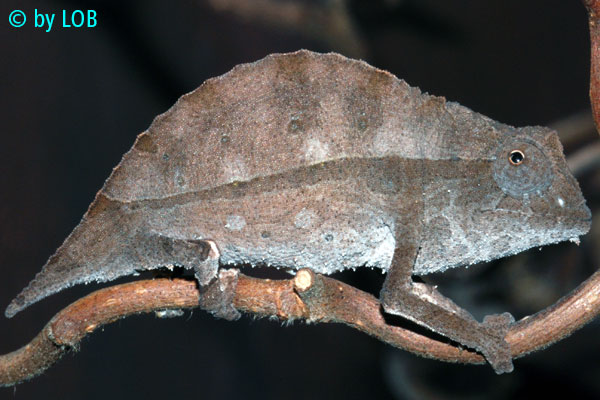
Rieppeleon brevicaudatus: Wild-caught female • Wildfangweibchen
© Lutz Obelgönner
© Lutz Obelgönner
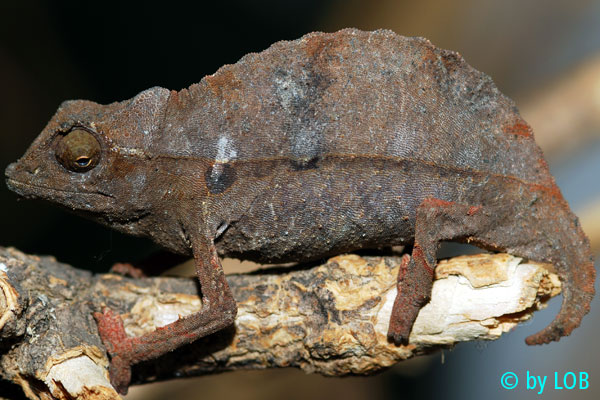
Rieppeleon brevicaudatus: Wild-caught male • Wildfangmännchen
© Lutz Obelgönner
© Lutz Obelgönner
Stump-tailed Chameleon / Bearded Pigmy Chameleon
Description
Named after Latin brevis='short' and caudatus='tailed' due to the shape of the tale. The dwarf chameleon species which is imported more often than all others even though it lives only in a restricted area in Tanzania. The obvious 'beard' makes it distinguishable from other species, the colouration is quite variable and covers different skin tones as well as different markings.
Protection
none
Adult Size
up to 80 mm
Lifespan
about three years
Distribution
Tanzania, Usambara Mountains, Uluguru Mountains
Habitat
ground and bush level of rain and mountain forests from 300–900 m above sea level
Captive Care
At least 40x30x40 cm WDH, but the animals don't mind to get more space with lots of plants and fine twigs. Control is easier in smaller boxes. Stick cork bark to the walls. Maximum temperature 25 °C, night temperature 20–22 °C, humidity 70–90 %, but always fresh air, sensitive to higher temperatures. Daylight fluorescent lamps or LEDs, substrate at least 3 cm sand/peat mix or forest soil, place leafs on top, keep always humid, spray daily.
Food
arthropods and larvae, woodlouses, other small invertrebrates, feed irregularly, minerals/vitamins (e. g. Herpetal Complete)
Reproduction and Rearing
Keep pairs. Females dig up to 6 clutches with 2–6 eggs/year into the ground. According to literature incubate at 20–22 °C for about 45 days. Own experience: 82 days at 17–22 °C.
Named after Latin brevis='short' and caudatus='tailed' due to the shape of the tale. The dwarf chameleon species which is imported more often than all others even though it lives only in a restricted area in Tanzania. The obvious 'beard' makes it distinguishable from other species, the colouration is quite variable and covers different skin tones as well as different markings.
Protection
none
Adult Size
up to 80 mm
Lifespan
about three years
Distribution
Tanzania, Usambara Mountains, Uluguru Mountains
Habitat
ground and bush level of rain and mountain forests from 300–900 m above sea level
Captive Care
At least 40x30x40 cm WDH, but the animals don't mind to get more space with lots of plants and fine twigs. Control is easier in smaller boxes. Stick cork bark to the walls. Maximum temperature 25 °C, night temperature 20–22 °C, humidity 70–90 %, but always fresh air, sensitive to higher temperatures. Daylight fluorescent lamps or LEDs, substrate at least 3 cm sand/peat mix or forest soil, place leafs on top, keep always humid, spray daily.
Food
arthropods and larvae, woodlouses, other small invertrebrates, feed irregularly, minerals/vitamins (e. g. Herpetal Complete)
Reproduction and Rearing
Keep pairs. Females dig up to 6 clutches with 2–6 eggs/year into the ground. According to literature incubate at 20–22 °C for about 45 days. Own experience: 82 days at 17–22 °C.
Stummelschwanzchamäleon
Generelles
Art benannt nach dem lateinischen brevis="kurz" und caudatus="geschwänzt". Die wohl am häufigsten importierte Zwergchamäleonart, die in Tansania nur in einem relativ kleinen Gebiet lebt. Auffällig ist der „Bart“ an der Unterseite der Schnauze, die Färbung ist sehr variabel und umfasst sowohl verschiedene Hauttöne als auch Zeichnungsvarianten.
Schutzstatus
keiner
Größe
bis 80 mm
Vorkommen
Tansania, Usambara-Berge, Uluguru-Berge
Habitat
Strauchschicht der Regen- und Bergwälder von 300–900 m über NN
Haltung
Mindestens 40x30x40 cm BTH, die Tiere nutzen aber gerne auch größere Becken mit vielen feinen Ästen und Pflanzen, Wände mit Kork bekleben. Die Kontrolle gelingt besser in kleinen Becken. Temperatur max. 25 °C, nachts 20–22 °C, Luftfeuchtigkeit 70–90 %, aber gute Belüftung. Tageslichtleuchtstoffröhre oder LEDs, Substrat mind. 3 cm hoch Sand-Torf-Mix immer feucht halten, darüber Laub streuen, täglich sprühen. Lebenserwartung: rund 3 Jahre.
Futter
Heimchen, Drosophila, Bohnenkäfer, Asseln, Buffalowürmer, andere kleine Wirbellose, immer mit Vitaminen und Mineralien versetzen (z. B. Herpetal Complete)
Zucht und Aufzucht
Paarhaltung. Weibchen legt bis zu 6 Gelege mit 2–6 Eiern/Jahr in den Bodengrund. Schlupf laut Literatur nach ca. 45 Tagen bei 20–22 °C. Eigene Erfahrung: 82 Tage bei 17–22 °C.
Art benannt nach dem lateinischen brevis="kurz" und caudatus="geschwänzt". Die wohl am häufigsten importierte Zwergchamäleonart, die in Tansania nur in einem relativ kleinen Gebiet lebt. Auffällig ist der „Bart“ an der Unterseite der Schnauze, die Färbung ist sehr variabel und umfasst sowohl verschiedene Hauttöne als auch Zeichnungsvarianten.
Schutzstatus
keiner
Größe
bis 80 mm
Vorkommen
Tansania, Usambara-Berge, Uluguru-Berge
Habitat
Strauchschicht der Regen- und Bergwälder von 300–900 m über NN
Haltung
Mindestens 40x30x40 cm BTH, die Tiere nutzen aber gerne auch größere Becken mit vielen feinen Ästen und Pflanzen, Wände mit Kork bekleben. Die Kontrolle gelingt besser in kleinen Becken. Temperatur max. 25 °C, nachts 20–22 °C, Luftfeuchtigkeit 70–90 %, aber gute Belüftung. Tageslichtleuchtstoffröhre oder LEDs, Substrat mind. 3 cm hoch Sand-Torf-Mix immer feucht halten, darüber Laub streuen, täglich sprühen. Lebenserwartung: rund 3 Jahre.
Futter
Heimchen, Drosophila, Bohnenkäfer, Asseln, Buffalowürmer, andere kleine Wirbellose, immer mit Vitaminen und Mineralien versetzen (z. B. Herpetal Complete)
Zucht und Aufzucht
Paarhaltung. Weibchen legt bis zu 6 Gelege mit 2–6 Eiern/Jahr in den Bodengrund. Schlupf laut Literatur nach ca. 45 Tagen bei 20–22 °C. Eigene Erfahrung: 82 Tage bei 17–22 °C.
Many thanks for valuable input to Søe Pedersen (†).
Literature / Literatur
Lantermann, W./Lantermann, Y. (2007). Chamäleons in den Ost-Usambara-Bergen im Norden Tansanias. Draco 7 (27): 45–48. NTV, Münster.
Lutzmann, N./Esser, S./Flamme, A./Schneider, H. (2004). Haltung und Vermehrung des Stummelschwanzchamäleons Rhampholeon brevicaudatus. Reptilia 9 (4): 28–33. NTV, Münster.
Lutzmann, N./Esser, S./Flamme, A./ Schneider, H. (2004). Rhampholeon brevicaudatus: care and breeding of the stump-tailed chameleon. Reptilia (English edition) (35): 22–27. Barcelona.
Necas, Petr/Schmidt, Wolfgang (2004). Stummelschwanzchamäleons. Die Gattungen Brookesia und Rhampholeon. Chimaira, Frankfurt.
Necas, Petr/Schmidt, Wolfgang (2004). Stump-tailed Chameleons. Miniature Dragons of the Rainforest. Chimaira, Frankfurt.
Necas, Petr/Schmidt, Wolfgang (2004). Geheimnisvolle Mini-Drachen: Die Erd- und Stummelschwanzchamäleons der Gattungen Brookesia und Rhampholeon. Reptilia 9 (4): 18–27. NTV, Münster.
Necas, Petr/Schmidt, Wolfgang (2004). Mysterious Mini-Dragons: the stump-tailed chameleons Brookesia and Rhampholeon. Reptilia (English edition) (35): 10–21. Barcelona.
van Hoof, J. et al. (2006). Kameleons, een fascinerende hobby. Lacerta 64 (5–6): 1–96.
Lantermann, W./Lantermann, Y. (2007). Chamäleons in den Ost-Usambara-Bergen im Norden Tansanias. Draco 7 (27): 45–48. NTV, Münster.
Lutzmann, N./Esser, S./Flamme, A./Schneider, H. (2004). Haltung und Vermehrung des Stummelschwanzchamäleons Rhampholeon brevicaudatus. Reptilia 9 (4): 28–33. NTV, Münster.
Lutzmann, N./Esser, S./Flamme, A./ Schneider, H. (2004). Rhampholeon brevicaudatus: care and breeding of the stump-tailed chameleon. Reptilia (English edition) (35): 22–27. Barcelona.
Necas, Petr/Schmidt, Wolfgang (2004). Stummelschwanzchamäleons. Die Gattungen Brookesia und Rhampholeon. Chimaira, Frankfurt.
Necas, Petr/Schmidt, Wolfgang (2004). Stump-tailed Chameleons. Miniature Dragons of the Rainforest. Chimaira, Frankfurt.
Necas, Petr/Schmidt, Wolfgang (2004). Geheimnisvolle Mini-Drachen: Die Erd- und Stummelschwanzchamäleons der Gattungen Brookesia und Rhampholeon. Reptilia 9 (4): 18–27. NTV, Münster.
Necas, Petr/Schmidt, Wolfgang (2004). Mysterious Mini-Dragons: the stump-tailed chameleons Brookesia and Rhampholeon. Reptilia (English edition) (35): 10–21. Barcelona.
van Hoof, J. et al. (2006). Kameleons, een fascinerende hobby. Lacerta 64 (5–6): 1–96.
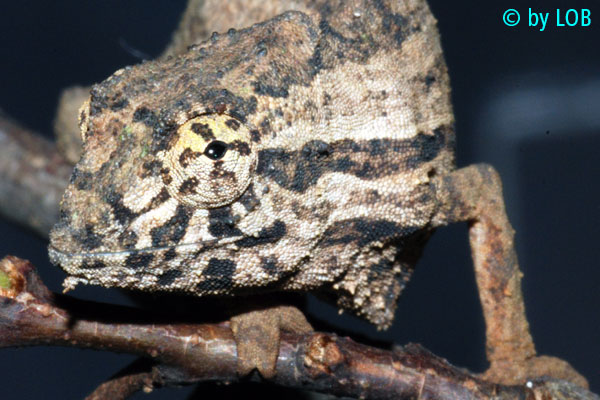
Rieppeleon brevicaudatus: Portrait of wild-caught male highlighting the typical 'beard' • Porträt eines Wildfangmännchens mit dem typischen "Bart"
© Lutz Obelgönner
© Lutz Obelgönner
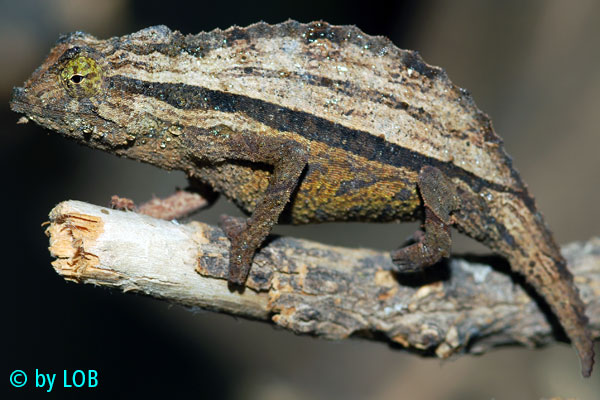
Rieppeleon brevicaudatus: Specimens show a high variation in patterns and colour, this is a male • Die Tiere zeigen eine hohe Variabilität in der Zeichnung und Färbung, hier ein Männchen
© Lutz Obelgönner
© Lutz Obelgönner
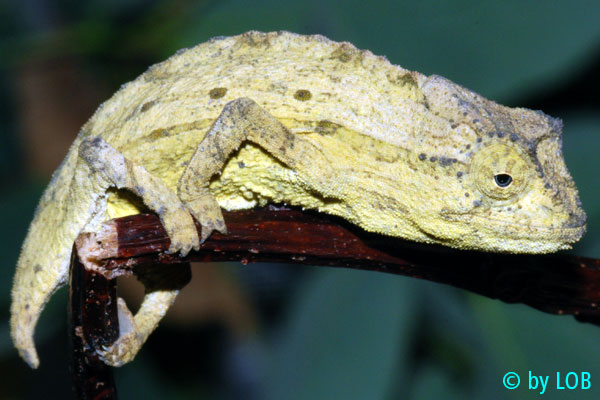
Rieppeleon brevicaudatus: Male showing yelow colouration • Männchen mit gelber Färbung
© Lutz Obelgönner
© Lutz Obelgönner
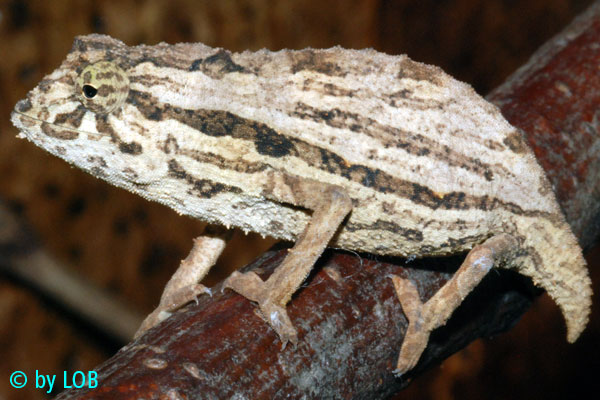
Rieppeleon brevicaudatus: Striped female • Gestreiftes Weibchen
© Lutz Obelgönner
© Lutz Obelgönner
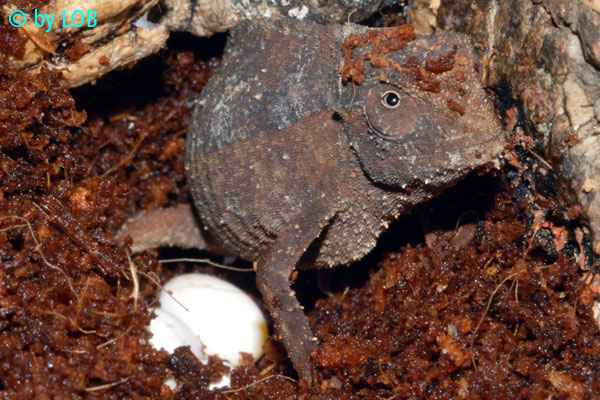
Rieppeleon brevicaudatus: Female depositing its eggs • Weibchen bei der Eiablage
© Lutz Obelgönner
© Lutz Obelgönner
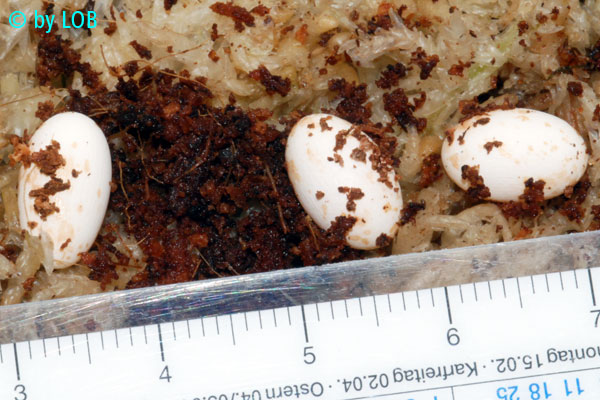
Rieppeleon brevicaudatus: Clutch on sphagnum in incubator • Gelege im Inkubator auf Sphagnum
© Lutz Obelgönner
© Lutz Obelgönner
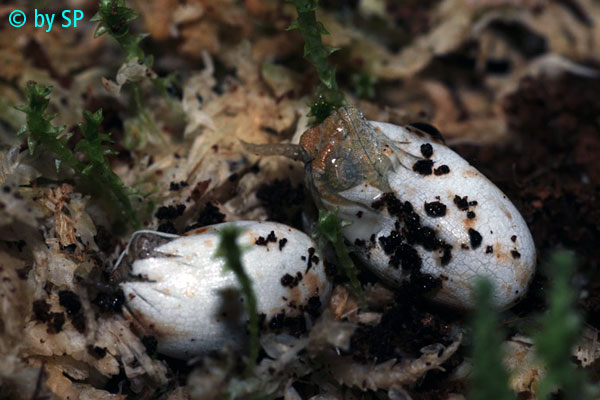
Rieppeleon brevicaudatus: Hatching • Schlupf
© Søe Pedersen
© Søe Pedersen
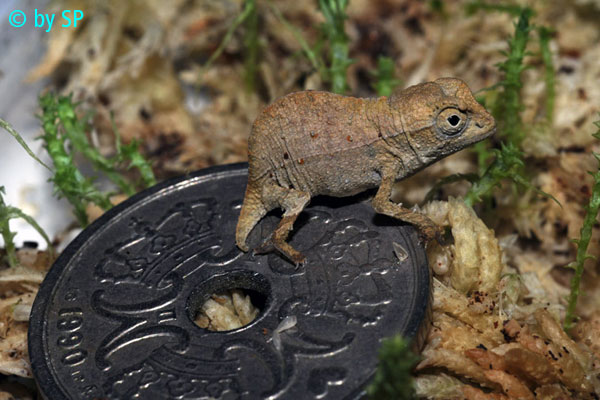
Rieppeleon brevicaudatus: Hatchling • Schlüpfling
© Søe Pedersen
© Søe Pedersen
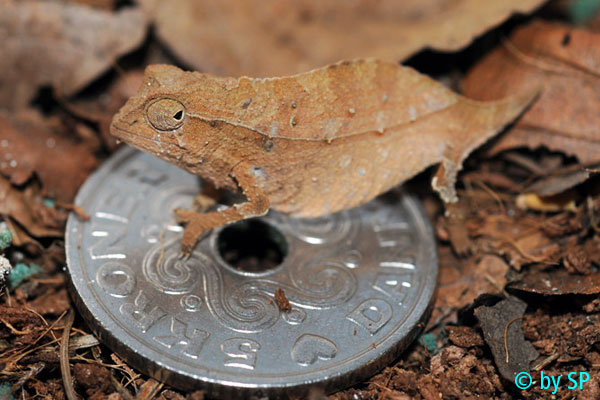
Rieppeleon brevicaudatus: One month old juvenile • Jungtier im Alter von einem Monat
© Søe Pedersen
© Søe Pedersen